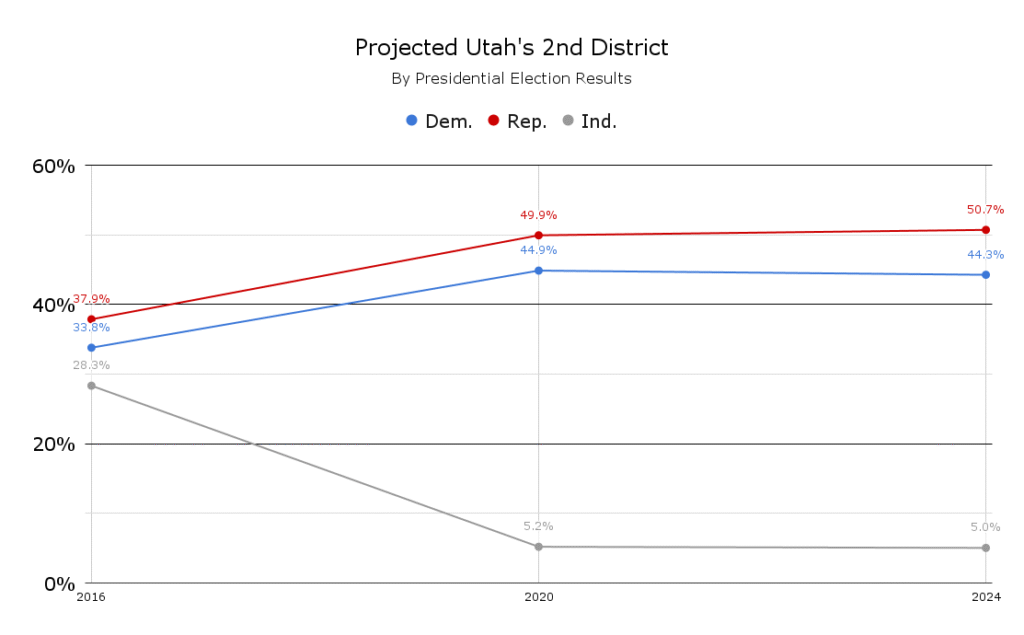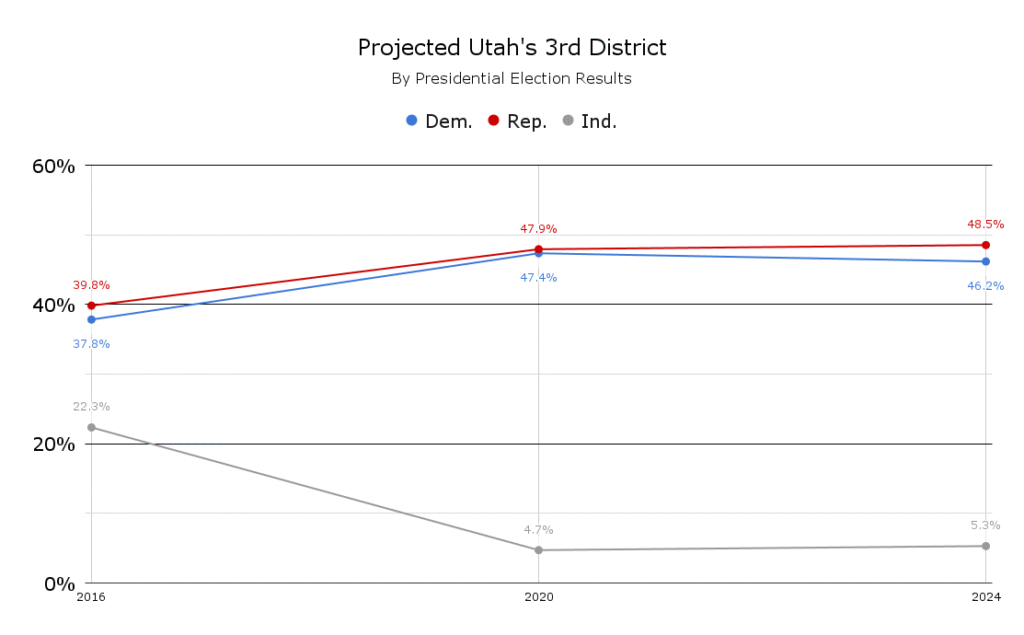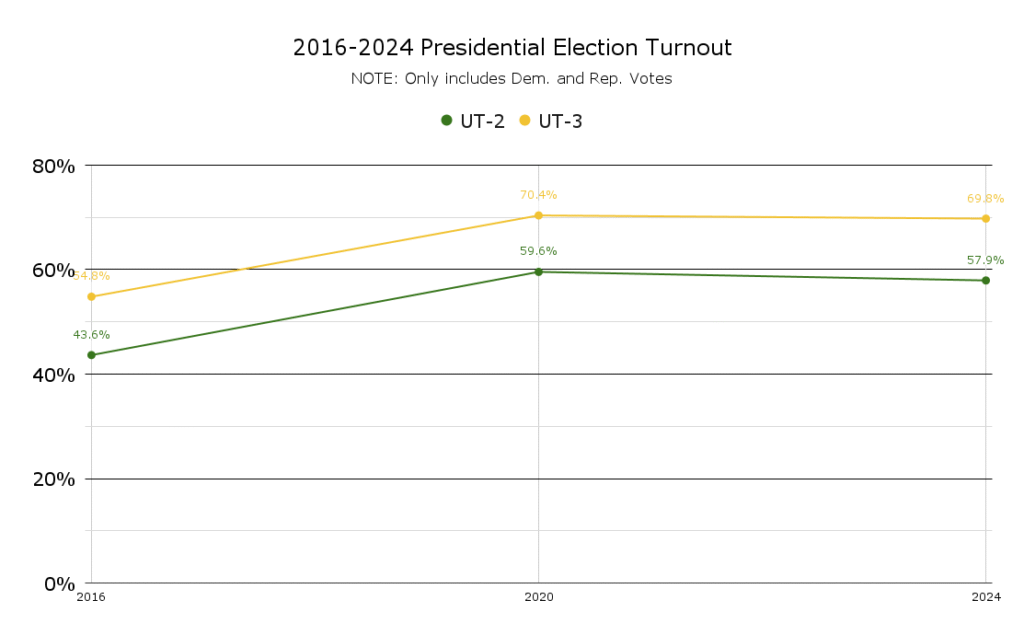Utah was recently forced to redraw their Congressional maps, after a judge, Judge Dianna Gibson of the Third District of Utah, ruled the map unconstitutional back in August of 2025. This wasn’t necessarily because of the maps themselves, but because the judge felt that the maps violated a independent redistricting commission that was passed by a public vote. The Utah Legislature immediately tried to dismantle the commission after it was passed in 2018, and was mostly successful, introducing new maps in 2021 that split Salt Lake City into 4.

Although the independent commission wasn’t restored, the Utah Legislature was forced to draw new maps that adhered to certain guidelines, and the map has to get the approval of Judge Gibson. What the Republican controlled Legislature came up with was a rather interesting solution, one that has all districts that voted for Trump in 2024, but also one that could backfire on Republicans. The main thing the new map has to adhere to is Salt Lake City County can only be divided among two districts, as opposed to four in the previous maps.

This map, also called Option C, is the one the Republicans will go with, and it does technically only split Salt Lake City into 2, but is still clearly gerrymandered. A fair map would almost certainly have 1 heavily Democratic district entirely within Salt Lake City, with 3 heavily Republican districts in the suburbs and the rural areas. Here’s an example of a fair map:

If Option C was to be struck down by Judge Gibson, we would expect the final maps to be something like this option. Option C has arguably 2 competitive districts, as well as 2 heavily Republican districts, a risky thing for Republicans to do considering the potential Dem-friendly environment in 2026. With that, let’s take a look a those two districts, which we’re called UT-02 and UT-03, and see what Democrats can do to get over the hump.

The new 2nd district voted for Trump by about 6% in 2024, and has remained at about Trump +5 since 2016. One thing to note is the extremely high independent number 2016, and it was still above average in 2020 and 2024. In 2016, Evan McMullin ran as an independent for President, but really only campaigned in Utah, taking a lot of former Romney voters with him. A lot of those voters in 2016 split between being Democratic and Republican in 2020, and things more or less stayed the same in 2024, although considering the nationwide shift of about R+6, this was actually a good performance for Dems.

The new 3rd district is similar to the new 2nd district, but it’s closer, with Biden only losing it by .5% in 2020. Trump won it by about 2% in 2024, but this is a very competitive district, and Democrats might even be favored in 2026, depending on who runs.

When it comes to turnout, this is where UT-2 gets interesting for Democrats. UT-2 was about average in 2024 when it comes to turnout, with the national average being about 58%. UT-3 is pretty maxed out on turnout though, with 70% being well above average, and thus not a ton of potential new voters. Even if in 2026 turnout will be lower in a midterm year, high turnout translates to midterms and presidential year elections, just on a different scale.
Demographically, both districts are also fairly similar. Both are majority white, considerably younger than the average 100K district, and most importantly, Mormon. We will get to how Mormonism plays a role in potential campaigns in a minute, but we want to go over a couple quick differences. The main reason why UT-3 is more competitive than UT-2 is due to the education levels and wealth of the district. More educated areas tend to vote more Democratic, especially in the Trump era, and UT-3 is above average in both Bachelor’s and Graduate’s attainment rate. UT-3 is also above average in household income, while UT-2 is at or just below average in both education and wealth. UT-2 however, is also more Hispanic than UT-3. UT-2 is about 20% Hispanic, which could play a factor in potential shifts in 2026, while UT-3 is only 11% Hispanic. One quick note: In the 1D map, the safe Democratic district would have both the Hispanic population and a lot of highly educated white people, while the proposed map basically splits them in two.
The big elephant in the room when it comes to anything Utah is that almost everyone in Utah is part of The Church of Jesus Christ of Latter-day Saints, aka the Mormon Church. The church has a very unique history that makes it different from most other strands of Christianity, but the thing that’s important for this discussion is, how can you use that to get over the edge in these districts? The key, at least in our opinions, is hammering home what Trump has done regarding his immigration and crime policies. The LDS has a structured leadership, and they aren’t exactly fans of Trump’s stances on immigration.
According to an article by the Salt Lake Tribune, leadership has explicitly told clergy to not ask about immigration status of their members, as well as supporting protecting Dreamer’s rights, saying “They have built lives, pursued educational opportunities and been employed for years based on the policies that were in place. These individuals have demonstrated a capacity to serve and contribute positively in our society, and we believe they should be granted the opportunity to continue to do so.” They also put out a statement in January where they affirm the following:
As disciples of Jesus Christ, the following principles guide the Church’s approach:
- The Church of Jesus Christ of Latter-day Saints obeys the law.
- We follow Jesus Christ by loving our neighbors. The Savior taught that the meaning of “neighbor” includes all of God’s children.
- We seek to provide basic food and clothing, as our capacity allows, to those in need, regardless of their immigration status. We are especially concerned about keeping families together.
Even if it’s not a condemnation of his policies, it’s also not exactly in support of them either, and in general they have been more pro immigration than other Evangelical Christian denominations in the US. We think while it’s important to keep your messaging about the economy with Trump, in Utah it’s also super important to focus on his immigration and crime policies, and highlighting the inhumanity of what’s going on.
Resources:
https://www.sltrib.com/religion/2025/04/25/lds-church-first-presidency-issues
